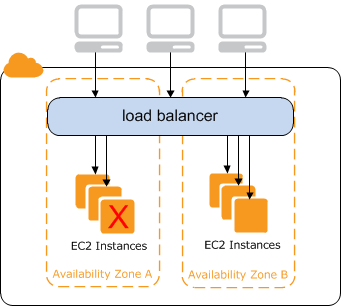What is a Classic Load Balancer?
Elastic Load Balancing automatically distributes your incoming traffic across multiple targets, such as EC2 instances, containers, and IP addresses, in one or more Availability Zones. It monitors the health of its registered targets, and routes traffic only to the healthy targets. Elastic Load Balancing scales your load balancer as your incoming traffic changes over time. It can automatically scale to the vast majority of workloads.
Elastic Load Balancing supports the following load balancers: Application Load Balancers, Network Load Balancers, Gateway Load Balancers, and Classic Load Balancers. You can select the type of load balancer that best suits your needs. This guide discusses Classic Load Balancers. For more information about the other load balancers, see the User Guide for Application Load Balancers, the User Guide for Network Load Balancers, and the User Guide for Gateway Load Balancers.
Classic Load Balancer overview
A load balancer distributes incoming application traffic across multiple EC2 instances in multiple Availability Zones. This increases the fault tolerance of your applications. Elastic Load Balancing detects unhealthy instances and routes traffic only to healthy instances.
Your load balancer serves as a single point of contact for clients. This increases the availability of your application. You can add and remove instances from your load balancer as your needs change, without disrupting the overall flow of requests to your application. Elastic Load Balancing scales your load balancer as traffic to your application changes over time. Elastic Load Balancing can scale to the vast majority of workloads automatically.
A listener checks for connection requests from clients, using the protocol and port that you configure, and forwards requests to one or more registered instances using the protocol and port number that you configure. You add one or more listeners to your load balancer.
You can configure health checks, which are used to monitor the health of the registered instances so that the load balancer only sends requests to the healthy instances.

To ensure that your registered instances are able to handle the request load in each Availability Zone, it is important to keep approximately the same number of instances in each Availability Zone registered with the load balancer. For example, if you have ten instances in Availability Zone us-west-2a and two instances in us-west-2b, the requests are distributed evenly between the two Availability Zones. As a result, the two instances in us-west-2b serve the same amount of traffic as the ten instances in us-west-2a. Instead, you should have six instances in each Availability Zone.
By default, the load balancer distributes traffic evenly across the Availability Zones that you enable for your load balancer. To distribute traffic evenly across all registered instances in all enabled Availability Zones, enable cross-zone load balancing on your load balancer. However, we still recommend that you maintain approximately equivalent numbers of instances in each Availability Zone for better fault tolerance.
For more information, see How Elastic Load Balancing works in the Elastic Load Balancing User Guide.
Benefits
Using a Classic Load Balancer instead of an Application Load Balancer has the following benefits:
-
Support for TCP and SSL listeners
-
Support for sticky sessions using application-generated cookies
For more information about the features supported by each load balancer type, see
Product comparisons
How to get started
-
To learn how to create a Classic Load Balancer and register EC2 instances with it, see Create an internet-facing Classic Load Balancer.
-
To learn how to create an HTTPS load balancer and register EC2 instances with it, see Create a Classic Load Balancer with an HTTPS listener.
-
To learn how to use the various features supported by Classic Load Balancers, see Configure your Classic Load Balancer.
Pricing
With your load balancer, you pay only for what you use. For more information, see Elastic Load Balancing Pricing